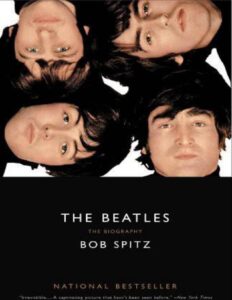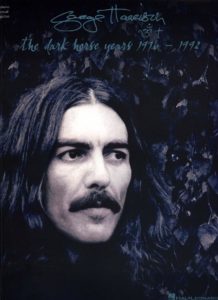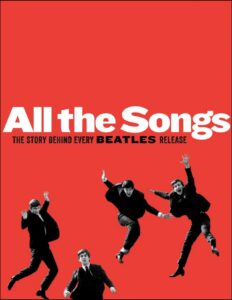Browse in the Library:
George Harrison (The Beatles) – Something (Guitar chords and melody with sheet music)

George Harrison
George Harrison was born on February 25, 1943, at 12 Arnold Grove Street, in the Wavertree district of Liverpool. That would be his home until he was six years old. His mother, Louise Harrison, was a housewife and worked in a greengrocer’s.
His father, Harold Harrison, had been a merchant seaman in his youth but left the sea to work as a bus driver. George had two brothers, Peter and Harold, and a sister, Louise. George attended Dovelade Primary School, two years behind Lennon.
He was a bad student, it was the worst time of his life. He kept three memories of Dovelade: the smell of boiled cabbage, a blonde girl and the Peter Pan house built by all the children. His secondary studies took him to the Liverpool Institute. Every morning when he went to class he was on the bus with a boy named Paul McCartney.

George’s love affair with music began at the age of 13. At that age his mother bought him his first guitar, which cost him a lot to learn to play. Once he mastered the technique, George began his career. He formed his own group, The Rebels. His brother Peter and a friend named Arthur Kelly accompanied him on this adventure.
The band didn’t last long but his desire and energy made him try to improve his guitar playing by listening to guitarists like Chet Atkins and Duane Eddy; he formed another band, Les Stewart Quartet. At this time, he combines his studies and music with a job at the Youth Employment Center as an electrician.
Young George began to be friends with Paul McCartney; They met on the bus on the way to school. They were both passionate about music and the guitar. Paul was then part of The Quarrymen, a group led by a young man named John Lennon. The friendship between them reached such a point that Paul invited George to attend some rehearsals of the band. In Paul’s mind, the idea of having George for the group was forged; Due to his youth, it took him a while to convince Lennon, but he got it. The Quarrymen got a stable lineup consisting of John Lennon, Paul McCartney, George Harrison, Pete Best and Stuart Sutcliffe.
In 1960, the group changed their name from The Quarrymen to the Silver Beatles, and headed to Hamburg. In the German city, they played eight hours a day every day and completed their training as musicians thanks to direct contact with the public. In Germany, they would meet Astrid Kirchner, a photographer who fell in love with Stuart and who designed the group’s new hairstyle.
The Beatles, they were already called that, they changed clubs. The owner of the club in which they had debuted did not sit well with the Beatles changing venues and revealed to the German authorities that George was only 17 years old and that he was too young to have a work permit. The band was forced to return to England.
With the permits already in order the band returned to Germany and continued playing. With many hours of flight, the boys decided to return to Liverpool with the exception of Stuart, who stayed in Germany with Astrid, where he would die months later.
In Liverpool, they start playing in a small club, The Caver. There Brian Epstein, the owner of a record store, sees them play and offers to be his manager. The boys accept and get a test with Pharlophone. Producer George Martin is happy with the group’s work, although he asks them that if they want to succeed, they must change the drummer.
They do without Pete Best and Ringo Star joins, whom they already knew from his time in Hamburg. In this way, The Beatles record Love Me Do and the story of the most important band in the history of modern music begins.
The 1960s were marked by the group. The Beatles became a musical and social phenomenon. In 1970 with Let it be in the street the demise of the group and the birth of the myth would be formalized.
Before the official separation, George Harrison had already shown his talent in compositions like Something, Taxman, While my guitar gently weeps or Here comes by Sun. The Lennon-McCartney duo had cornered the guitarist’s talent, but the quality of George Harrison’s composition did not go unnoticed by Beatles fans. This fact made George start to fly on his own and record some experimental albums like Wonderwall music in 1968 and Electric Sound in 1969.
George became the first member of the band to reach number one solo thanks to My Sweet Lord, which was included on the album All Things Must Pass (1970). The following year he returned to the charge organizing a concert in Madison Square Garden in favor of Bangladesh, the result was The Concert for Bangladesh, a direct triple that was very successful. This work was followed in 1972 by Living in the material world, an album that reached number one in the United States.
George’s next album, Dark Horse, came in 1974, followed by Extra Texture in 1975, Thirty Three and 1/3 in 1976 and George Harrison in 1978. The eighties began for George with Somewhere in England, an album in which All those years ago stood out, the tribute that the guitarist paid to the assassinated John Lennon.
The following year, Gone Troppo would see the light. We had to wait five years, until 1987, for Cloud Nine to be published. After this album he would be part of The Traveling Wilburys along with Bob Dylan, Jeff Lynne, Roy Orbison and Tom Petty, with whom he would dedicate himself to performing live in the United States.
His last appearance in the world of music would take place in 1995. George met with Paul and Ringo to launch the Beatles Anthology, a release that brought under his arm an unreleased song, Free as a bird.
In 2002, a year after his death, Brainwashed was released, the posthumous album that Geroge Harrison left almost finished and whose production was carried out by former ELO Jeff Lynne and his own son, Dhani.
During the recording of A Hard Day’s Night, George met Pattie Boyd. George fell in love with the model and on January 21, 1966, they were married. Shortly thereafter, the quiet Beatle met guitarist Eric Clapton. An excellent friendship developed between the two despite the fact that Eric felt something special for Pattie, not in vain was she the muse that inspired Layla. Clapton instilled confidence in George and made him see that he was a great guitarist.
The relationship between George and Pattie lasted almost 11 years. In 1977 Pattie left the former Beatle for Eric Clapton. That same year, George met Olivia Arias, a secretary of Mexican origin who worked at his record company. The crush was immediate and a year later they already had their first and only child, Dhani.
Hinduism
George’s greatest passion was undoubtedly India. In the mid-1960s, the musician came into contact with the civilization, history, philosophical and spiritual currents of the Asian country. The strengthening of the relationship between George and India came about thanks to two people: Ravi Shankar and the Maharishi Mahes Yogi.
The influence of Shankar, a musician who was an institution in his country, was decisive in George to the point that the beatle began to investigate the sounds of Hindu music, especially the sitar, an instrument that he quickly mastered, reaching to introduce it in some songs of the group like Nowerian wood.
And if Ravi Shankar introduced George to Hindu music, the Maharishi Mahesh Yogi was in charge of showing George and his companions the secrets of transcendental meditation, karma and, above all, pacifism.
In 2017, his song “What Is Life”, single from “All Things Must Pass”, was included in the soundtrack of the movie “La Batalla De Los Sexos” (2017).
The same year she played ‘Wah-Wah’, another cut of ‘All Things Must Pass’ in the movie ‘Barry Seal’ (2017) and ‘Blow Away’ in ‘Molly’s Game’ (2017).
In 2018, she played “What Is Life” in the comedy “Familia Al Instante” (2018).
In 2019, the documentary “An Accidental Studio” (2019) was released, a film about his production company HandMade.
In 2021, with archival material, the singles ‘Run Of The Mill’ and ‘Cosmic Empire’ were released.
Best Sheet Music download from our Library.
Browse in the Library:
The intimate life of George Harrison, the ‘beatle’ neither so quiet nor so peaceful
‘I Me Mine’ is published for the first time in Spanish, a book where the musician describes his anguish and vices and reveals a complex personality
George Harrison writes: “I can’t take it anymore. I decided: this far we have come. This isn’t fun anymore, being in this band is depressing, this is all bullshit, thanks, I’m leaving… John and Yoko had terrible tantrums and spent the time yelling at each other. I left the band, I went back to my house… and I wrote this tune”.
The musician attaches this text about the song Wah-Wah, included in his masterpiece, All Things Must Pass, which for many is the best solo album by a member of The Beatles. ‘Wah-Wah is a headache,’ he explains in the same note. The song says: “You have made me a big star by being there at the right time. / But I don’t need no wah-wah anymore, and I know how sweet life can be if I can get away.
That’s what Harrison (Liverpool, 1943-Los Angeles, 2001) suffered in the last stage of The Beatles, back in 1969. This revelation and many more can be read in the book I Me Mine, the closest thing to an autobiography of the star of the rock (much to his regret) published in 1980 in a limited edition (2,000 copies signed by the artist) and now translated into Spanish by the Libros del Kultrum publishing house.
I Me Mine shows the keys to the complex personality of Harrison, who was neither quiet nor always led a peaceful life. It was signed by the two women he married. Pattie Boyd, to whom he was married from 1966 to 1977, said in her biography, Wonderful Tonight: ‘Yes, he would meditate for hours, but when the temptation of the flesh came, he would get high and party.’
From 1978 until his death, he lived with Olivia Harrison, who pointed out in a Rolling Stone report: “For George, black and white, up and down, were not different things. He could be the quietest in the world, but he could also be the loudest. Once the engines were hot, there was no human power that could stop it.” Let’s remember: Harrison loved speed, he was a crazy follower of Formula 1, he traveled the world to be next to the drivers of the time: Niki Lauda, Graham Hill or Jackie Stewart.
Other topics about Harrison’s life are true: that John Lennon and Paul McCartney plugged his talent in The Beatles. He managed to sneak into the quartet records Something, Here Comes the Sun or While My Guitar Gently Weeps, because Paul and John did not have the courage to reject some songs that they would have liked to compose themselves.
They did despise, however, All Things Must Pass, which Harrison later placed as the flag for his solo album. McCartney surrendered to the song years later, performing it live. In a concert in Madrid he played it after saying, in Spanish: “This is in memory of my friend George”. It was 2004 and Harrison had passed away three years earlier.
Although in the early years he thoroughly enjoyed it, after 1965 the guitarist hated being a beatle. “The Beatles were doomed. Your own space, friend. It is a very important thing. That’s why we were doomed, because we didn’t have it. It’s what happens with the monkeys in the zoo. They die. You know, everyone needs to be left alone,” he writes.
That busy Beatle life is dramatized in the book as he explains the inspiration for Here Comes The Sun. “Apple [the company that set up the quartet] was becoming something like a school where we had to go and act like businessmen, endorse invoices all day, sign this and sign this. One day I decided to play hooky. I went to Eric Clapton’s house and started walking in the garden. I felt wonderful relief that I didn’t have to be with those stupid accountants. I wandered around the garden with one of Eric’s acoustic guitars and wrote Here Comes the Sun.’
In the book you can see the unsophisticated elements on which he writes: sheets of hotel letterhead, a letter envelope, a page from a cheap notebook or leaflets that read ‘hare krishna.’ In I Me Mine comes a guy with sharp English humor. “I prefer to be an ex-Beatle than an ex-Nazi”, he clarified, and that each one draw their own readings from him.
The guitarist always admired Lennon, his talent, and was disappointed when he built a closed and schizophrenic world with Yoko Ono. Some of Lennon’s songs would not have reached excellence without the arrangements and small contributions of Harrison. However, they must not have seemed worth much to John, because he never credited Harrison. In the case of Eric Clapton, however, the musical admiration was mutual and reverential. Not even the love shared with Pattie Boyd, who was first married to Harrison and then to Clapton, managed to separate them.

In Clapton’s memoir Autobiography ( available in our Library), the guitarist recounts in detail his long courtship with Boyd. With intimate anecdotes like this: “I started hanging out in Friar Park [Harrison’s 120-room English mansion] hoping George would be out, so I could get a few moments alone with Pattie. I went there one night and found them both in bed with [actor] John Hurt. I was a little perplexed, but George took charge of the situation, gave me a guitar, and we started playing”.
Already out of the Beatles, he rose to prominence with All Things Must Past (1971), the first triple album in the history of rock, a vital manifesto where a man dedicated to a spirituality that he embraced in India was seen and that he was enlarging until his death. The friendship and music that he shared with Ravi Shankar, the solidarity concert for Bangladesh (the precedent of Live Aid), his figure as producer of films of his admired Monty Python and a routine increasingly withdrawn from what hated most: being a rock star “I never liked those people who break guitars. That’s pure rubbish”, he lashes out at one of rock’s iconographies, personalized in Jimi Hendrix or Pete Townshend.
Although he continued to release records in the eighties, he always seemed to be in retreat. He thoroughly enjoyed Traveling Wilburys, that impossible group that he formed with his idolized Bob Dylan, Roy Orbison, Tom Petty and Jeff Lynne, the latter in charge of putting all that talent in order. He got it, with two delicious albums (1988 and 1990).
In 1999, all his anti-fame ghosts were shown in a dramatic way: an unbalanced man sneaked into his mansion and, after struggling with him and his wife, Olivia, reached the musician’s lung with a knife. Although he recovered, his only son (the fruit of his relationship with Olivia), also a musician Dhani, pointed out that the aftermath weakened him in his fight against cancer. A pathology that was diagnosed in 1997 in his throat (Harrison was a heavy smoker) and that later spread to other parts of the body, causing his death on November 29, 2001. He was 58 years old.
Harrison spent the last part of his life in overalls, equipped with shears, hedge trimmers, hoses, and brush cutters, moving through the undergrowth of his huge house in Friar Park. He said: “Actually, I’m a very simple guy. I don’t want to be in the business all the time, because I’m a gardener. I plant flowers and see how they grow. I don’t go to clubs or parties. I stay home and watch the river flow.’
